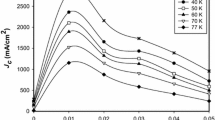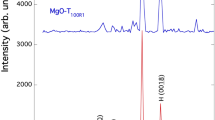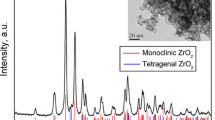Abstract
Ag sheathed (Bi1.6Pb0.4)Sr2Ca2Cu3O y (Co3O4) x superconductor tapes with addition of Co3O4 nanoparticles (with size 30 and 50) were fabricated using the powder-in-tube (PIT) method. The structure and microstructure were studied along with critical temperature (T c) and transport critical current density (J c). The nanoparticle added tapes showed a higher J c value compared with the non-added tapes. The 30-nm Co3O4 added tapes showed a higher J c value compared with the 50 nm Co3O4 added tapes. This study showed that Co3O4 nanoparticles could act as effective pinning centers leading to enhancement of J c in the Bi-2223/Ag sheathed tapes. The addition of smaller Co3O4 nanoparticles (30 nm) results in stronger pinning. The full vortex magnetic energy due to addition of Co3O4 magnetic nanoparticles led to the enhancement of J c.
Similar content being viewed by others
Avoid common mistakes on your manuscript.
1 Introduction
Large-scale applications of high-critical temperature (T c) superconductors at liquid nitrogen temperature under magnetic fields require high transport critical current density. The flux pinning capability is one of the basic parameters that is important for the application of superconductors. In order to enhance the flux pinning properties and improve the transport current density, many attempts have been made by introducing artificial defects of nanometer size as possible pinning centers [1–6]. The improvement in transport critical current density (J c) can be obtained by introducing an efficient pinning center with size that matches the coherence length. Magnetic nanoparticles have been suggested as effective pinning centers [7, 8]. The use of magnetic nanoparticles with various shapes such as nanorod has been suggested to increase the pinning potential and thus enhance J c [9].
The two important characteristic lengths in superconductors are the coherence length (ξ) and penetration depth (λ). Generally, the critical current density will increase when the size of magnetic particles is increased, and L is larger than ξ but smaller than λ [10]. In another report however, pinning is expected to be optimized when the size of the defects approaches the coherence length. The coherence length of Bi2Sr2Ca2Cu3O10 is 2.9 nm [11] and penetration depth is in the range of 60–1000 nm. Provided that the particle size is carefully controlled i.e. between 2.9 and 60 nm and the dopant level is kept below a critical threshold, the addition of nanoparticles may improve the flux pinning [9, 12].
The J c of the nano-sized Fe3O4 added tapes is 5130 A/cm 2 at 77 K and 23130 A/cm 2 at 30 K in zero fields. Fe3O4 can act as an effective flux pinning center leading to enhancement of J c in the bulk as well as the tape form [13]. The J c (77 K) of the 6-nm ZnOadded sample was 46 times larger than that of the non-ZnOadded sample [14]. In nano-sized MgOadded tapes, the temperature and magnetic field dependence of J c exhibited significant enhancement compared with the non-added tapes [15]. The nanoparticle with size closer to the coherence length was suggested to be more effective in enhancing J c [13–15].
Most studies on enhancing J c only used one size nanoparticles. It is interesting to investigate the effect of different sized magnetic nanoparticles on the transport current properties of the Bi-2223 superconductors. In this work, Co3O4 magnetic nanoparticles with an average size of 30 and 50 nm were added into Bi1.6Pb0.4Sr2Ca2Cu3O10 (Bi-2223) Ag-sheathed tapes. These sizes were chosen because according to a previous theoretical study [9], when the magnetic nanoparticle size is larger than the coherence length but smaller than the penetration depth, enhanced flux pinning is expected. Nano-Co3O4 is superparamagnetic above 45 K, ferromagnetic between 25 and 45 K, and antiferromagnetic below the transition temperature of 27 K which is less than that of the bulk value T N = 33 K [16]. The effect of these nanoparticles on the microstructure and the electrical transport properties of Bi-2223/Ag tapes are reported.
2 Experimental Details
Superconductor powders with nominal starting composition (Bi1.6Pb0.4)Sr2Ca2Cu3O y (Co3O4) x (x = 0–0.05 w t %) were synthesized using the co-precipitation method. The average particle size of Co3O4 was 30 and 50 nm. Using the results from the polycrystalline samples that showed that J c was optimized with 0.02 wt % in 30-nm Co3O4added pellets and 0.01 wt % in 50-nm Co3O4added pellets, Ag-sheathed superconductor tapes were fabricated using the powder-in-tube method. The (Bi1.6Pb0.4)Sr2Ca2Cu3O10 powders were added with 0.02 wt % Co3O4 (30 nm) and 0.01 wt % Co3O4 (50 nm) nanoparticles before being packed into a Ag tube with an outer diameter of 6.03 mm and an inner diameter of 4.43 mm. The tube was drawn into a 1 mm wire by extrusion process and then pressed into tape of 0.30 mm in thickness and 1.53 mm in width. The tapes were then sintered at 845∘ C for 50 h and cut into 3 cm sections for J c measurements.
The electrical resistance–temperature measurements were carried out using the four-point probe technique in conjunction with a CTI cryogenics closed-cycle refrigerator (model 22). The four-point probe method using the 1- μV/cm criterion was used to measure the transport critical current density (J c) between 30 and 77 K. J c was also measured in a magnetic field of 0–0.75 T at 77 K.
The phase was determined using the X-ray diffraction (XRD) method by employing a Bruker D8 Advance diffractometer. The size of Co3O4 was determined using a Philips transmission electron microscope (TEM) (model CM12).
3 Results and Discussion
The average size of Co3O4 particles calculated from the TEM micrographs was 30 ± 4 and 50 ± 4 nm. Figure 1 shows the TEM micrograph of the 30-nm Co3O4 particles. Figure 2 shows the XRD patterns of the tapes with x = 0 w t %, x = 0.02 w t % of Co3O4 (30 nm), and x = 0.01 w t % of Co3O4 (50 nm). X-ray diffraction patterns show that the Bi-2223 is the major phase, while the Bi-2212 is the minor phase in all tapes.
Figure 3 shows the microstructure of the x = 0 wt %, x = 0.02 wt % of Co3O4 (30 nm), and x = 0.01 wt % of Co3O4 (50 nm) tapes. Plate-like grains are observed in the non-added sample that is normally observed in the Bi-based system. The non-added sample showed a larger grain size than the sample with nano-Co3O4. The grain morphology of all the added samples was almost similar, except for minor variations in texture and porosity.
Figures 4 and 5 shows the critical current density versus Co3O4 content in polycrystalline Bi1.6Pb0.4Sr2Ca2Cu3O10 at 30 and 77 K. The highest J c was observed in the x = 0.02 wt % Co3O4 (30 nm) sample and in the x = 0.01 wt % Co3O4 (50 nm) sample [17]. Figure 6 shows the temperature dependence of J c in zero magnetic fields for x = 0 wt %, x = 0.02 wt % of Co3O4 (30 nm), and x = 0.01 wt % of Co3O4 (50 nm)-added tapes. Table 1 shows the J c of Bi1.6Pb0.4Sr2Ca2Cu3O10 tapes with and without the addition of Co3O4 nanoparticles at 30 and 77 K in zero fields. J c for the added samples was higher than that for the non-added tape. The highest J c at 30 K (22800 A/cm 2) and 77 K (6840 A/cm 2) was shown by the sample with Co3O4 (30 nm). This result showed that Co3O4 nanoparticles enhanced the transport critical current density in the bulk and tape samples. In the intermediate temperature region (between 35 and 55 K), the J c of the 50-nm Co3O4-added tapes was higher than that of the 30-nm Co3O4-added tapes. This indicated the possible different flux pinning mechanisms in this region for the two tapes.
The magnetic field dependence of the critical current density at 77 K with fields parallel and perpendicular to the tapes’ surface is shown in Fig. 7. The J c decreased when the magnetic field was applied parallel to the surface of the tape due to the strong anisotropy of Bi-2223. The J c of tape with x = 0.01 wt % of Co3O4 (50 nm) tape decreased faster than that with x = 0.02 wt % of Co3O4 (30 nm) tape. The nano-sized particles introduced into the granular networks are believed to act as possible pinning centers, and this improved the microstructure and strengthens the weak links between grains.
In conclusion, the effect of nano-sized Co3O4 addition on flux pinning capability of (Bi1.6Pb0.4)Sr2Ca2Cu3O10 tape was investigated. The highest J c in the tapes was observed in the sample with x = 0.02 wt % Co3O4 (30 nm). All the nanoparticleadded samples showed a higher J c value compared with the non-added samples. This study showed that the magnetic nanoparticles could act as effective pinning centers leading to enhancement of J c. The preparation method can be further optimized to improve the electrical transport properties. The flux line network and the magnetic texture can interact effectively if their characteristic scales have the same order of magnitude. Generally, when the size of a pinning center is larger than ξ gut smaller than λ, the critical current density will increase. The average size of the Co3O4 used in this study is L = ∼30–50 nm, and this satisfies the requirement ξ < L < λ for a frozen flux superconductor, which is likely an explanation for the enhanced J c in the system. The full vortex magnetic energy from the addition of Co3O4 magnetic nanoparticles played an important role in enhancing J c in Bi1.6Pb0.4Sr2Ca2Cu3O10/Ag tapes.
References
Jiang, J., Chai, X.Y., Polyanskii, A.A., Schwartzkopf, L.A., Larbalestier, D.C., Parrella, R.D., Li, Q., Rupich, M.W., Riley Jr., G.N.: Supercond. Sci. Technol. 14, 548 (2001)
Pu, M.H., Song, W.H., Zhao, B., Wu, X.C., Hu, T., Sun, Y.P., Du, J.J.: Supercond. Sci. Technol. 14, 305 (2001)
Çelebi, S., Düzgün, I.: Supercond. Sci. Technol. 22, 034018 (2009)
Abd-Shukor, R., Yahya, S.Y., Jumali, M.H., Hamadneh, I., Halim, S.A.: J. Phys. : Conf. Series 43, 71 (2006)
Abd-Shukor, R., Awang Kechik, M.M., Halim, S.A.: J. Phys: Conf. Series 97, 012050 (2008)
Kusevic, I., Simundic, P., Babic, E., Ionescu, M., Liu, H.K., Dou, S.X.: Solid State Comm. 100, 187 (1996)
Yang, Z.Q., Su, X.D., Qiao, G.W., Guo, Y.C., Dou, S.X., de Boer, F.R.: Physica C 325, 136 (1999)
Ghattas, A., Annabi, M., Zouaoui, M., Ben Azzouz, F., Ben Salem, M.: Physica C 468, 31 (2008)
Lyuksyutov, I.F., Naugle, D.G.: Mod. Phys. Lett. 13, 491 (1999)
Mousavi Ghahfarokhi, S.E., ZargarShoushtari, M.: Physica B 405, 4643 (2010)
Gul, I.H., Amin, F., Abbasi, A.Z., Anis-ur-Rehman, M., Maqsood, A.: Physica C 449, 139 (2006)
Albiss, B.A., Obaidat, I.M., Gharaibeh, M., Ghamlouche, H., Obeidat, S.M.: Solid State Comm. 150, 1542 (2010)
Abd-Shukor, R., Kong, W.: J. Appl. Phys. 105, 07E311 (2009)
Agail, A., Abd-Shukor, R.: Appl. Phys. A 112, 501 (2013)
Yahya, N.A.A., Abd-Shukor, R.: Adv. Cond. Mat. Phys. Article ID, 821073 (2013)
Ozkaya, T., Baykal, A., Koseoğlu, Y., Kavas, H.: Cent. Eur. J. Chem. 7, 410 (2009)
Jannah, A.N., Abdullah, H., Abd-Shukor, R.: Adv. Cond. Mat. Phys. Article ID, 498747 (2014)
Acknowledgments
This research was supported by the Ministry of Education, Malaysia, under grant no. FRGS/2/2013/SG02/UKM/01/1 and the Universiti Kebangsaan Malaysia under grant no. UKM-DIP-2012-032.
Author information
Authors and Affiliations
Corresponding author
Rights and permissions
About this article
Cite this article
Jannah, A.N., Abdullah, H. & Abd-Shukor, R. Enhanced Transport Critical Current Density in Ag-Sheathed (Bi1.6Pb0.4)Sr2Ca2Cu3O y Superconductor Tapes with Different Nano-Sized Co3O4 Addition. J Supercond Nov Magn 28, 1471–1476 (2015). https://doi.org/10.1007/s10948-014-2921-5
Received:
Accepted:
Published:
Issue Date:
DOI: https://doi.org/10.1007/s10948-014-2921-5











